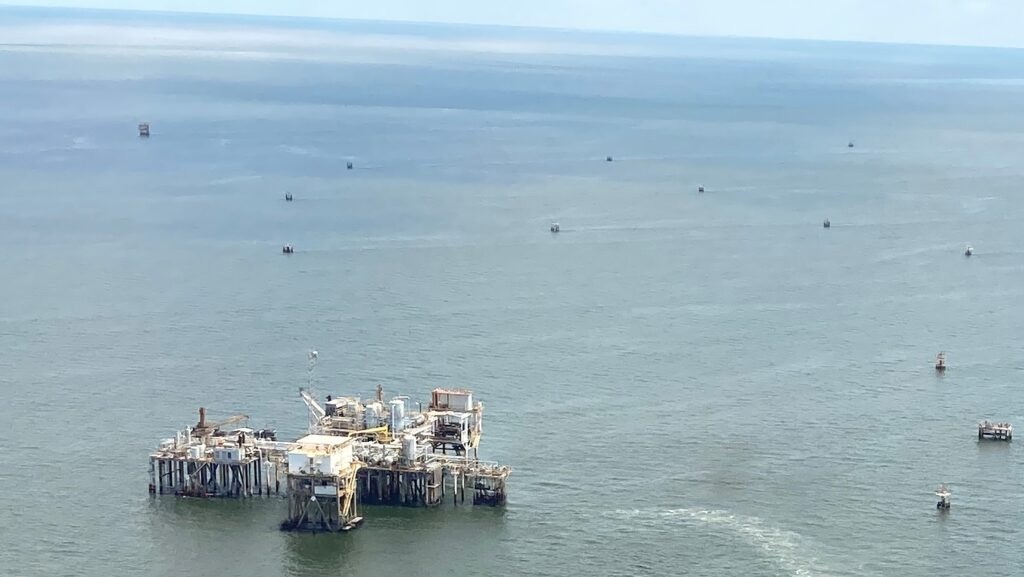A group led by the University of Michigan discovered that the nation’s largest offshore fossil fuel production region has double the climate warming impact as official estimates by accurately measuring greenhouse gas emissions from an aircraft flying over the Gulf of Mexico.
 Central-hub multi-platform complexes in the Gulf of Mexico emit far more methane than official inventories report, according to a study led by the University of Michigan. Researchers flew over the region in a Mooney airplane to measure greenhouse gas emissions. This photo, from one of their flights, shows a central hub collecting oil and gas from surrounding smaller satellite production platforms. Image Credit: Paolo Wilczak.
Central-hub multi-platform complexes in the Gulf of Mexico emit far more methane than official inventories report, according to a study led by the University of Michigan. Researchers flew over the region in a Mooney airplane to measure greenhouse gas emissions. This photo, from one of their flights, shows a central hub collecting oil and gas from surrounding smaller satellite production platforms. Image Credit: Paolo Wilczak.
The findings could have an impact on future energy production in the Gulf, as choices regarding expanding oil and gas extraction are based on climate impact projections.
While there has previously been a difference between reported and observed methane emissions in the basin, this study is considered the first to calculate methane and carbon dioxide emissions and understand the key culprits. It turns out that older, closer-to-land platforms generate significantly more methane than is indicated in government inventories.
According to scientists, simple measures could go a long way toward minimizing those discharges.
The researchers conducted their atmospheric observations by flying upward and downward in a cylindrical pattern around the platforms, measuring the amounts of carbon dioxide and methane released. They integrated aircraft measurements with all prior field studies to collect the greatest sample size of GHG emissions from Gulf of Mexico platforms. Their findings instantly drew attention to specific oil and gas production operations.
What we found is that a certain type of shallow water platform had large methane emissions that elevated total greenhouse gas emissions for the entire Gulf of Mexico. So if we can direct mitigation efforts at those sources to address the problem, it could have a huge positive effect.
Eric Kort, Associate Professor, Climate and Space Sciences and Engineering, University of Michigan
Eric Kort is the Principal Investigator of the F3UEL project and Corresponding Author of the research published in the Proceedings of the National Academy of Sciences.
These are larger “central-hub” multiplatform complexes that gather and process oil and gas from modest production platforms. Due to direct venting into the environment or escapes from tanks and other equipment, sampling revealed that these produce more methane than expected.
Actions to reduce these massive methane emissions, whether by absorbing the gas, flaring it instead of venting, or fixing or abandoning infrastructure, might have a significant impact on the climate.
The observation is similar to one made by the same scientists in September, which discovered that inefficient flaring activities on land were releasing five times more methane into the atmosphere than projected.
These studies, taken together, highlight the need for a more thorough method of estimating greenhouse gas emissions, and hence the climate impact of oil and gas production in a specific region. The “carbon intensity,” a metric measuring the levels of greenhouse gases emitted per unit of oil or gas produced, determines the climate effect.
When new oil and gas projects are being considered, authorities analyze whether the carbon intensity of the new projects will be the same or lower than the carbon intensity of expanded production elsewhere. This has already had an impact on choices regarding the sale of oil and gas leases in the Gulf of Mexico.
However, estimates of carbon dioxide and methane emitted into the atmosphere in these evaluations have historically not been based on actual observations, and many of them have not included methane emissions.
We have presented the climate impact of both oil and gas production as an observation-based carbon intensity. This metric reflects a snapshot of real-time climate impacts and offers an easy way to integrate the growing number of field surveys of emissions from fossil fuel production into a consistent metric. Moving forward, policy or investment decisions can use consistent metrics such as this to choose fossil fuels from locations that minimize their climate impacts.
Alan Gorchov Negron, Study First Author and Graduate Student Research Assistant, University of Michigan
Investigators from Stanford University, Scientific Aviation, Carbon Mapper and Environmental Defense Fund participated in the research.
The study is supported by the Alfred P. Sloan Foundation with additional support from the Environmental Defense Fund, Scientific Aviation and U-M’s Department of Climate and Space Sciences and Engineering and Graham Sustainability Institute.
Journal Reference:
Gorchov Negron, A. M., et al. (2023). Excess methane emissions from shallow water platforms elevate the carbon intensity of US Gulf of Mexico oil and gas production. Proceedings of the National Academy of Sciences. doi.org/10.1073/pnas.2215275120.